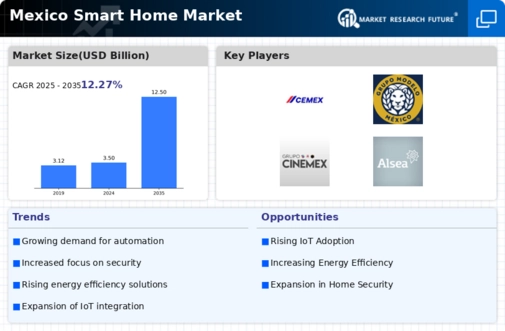The smart home market in Mexico is characterized by a dynamic competitive landscape, driven by rapid technological advancements and increasing consumer demand for automation and connectivity. Major players such as Amazon (US), Google (US), and Xiaomi (CN) are strategically positioned to leverage their extensive ecosystems and innovative product offerings. Amazon (US) focuses on enhancing its Alexa-enabled devices, while Google (US) emphasizes integration with its Google Home platform. Xiaomi (CN) continues to expand its affordable smart home solutions, appealing to a broad consumer base. Collectively, these strategies foster a competitive environment that prioritizes innovation and user experience, thereby shaping market dynamics.
Key business tactics employed by these companies include localizing manufacturing and optimizing supply chains to enhance efficiency and reduce costs. The market structure appears moderately fragmented, with a mix of established brands and emerging players vying for market share. This fragmentation allows for diverse product offerings, catering to varying consumer preferences and price points, while the influence of key players remains substantial in setting industry standards and trends.
In October 2025, Amazon (US) announced the launch of a new line of smart home security devices, which integrates advanced AI capabilities for real-time monitoring and alerts. This strategic move not only enhances Amazon's product portfolio but also positions the company as a leader in the security segment of the smart home market. By leveraging AI, Amazon (US) aims to provide consumers with enhanced safety features, thereby increasing customer loyalty and market penetration.
In September 2025, Google (US) unveiled a partnership with local telecommunications providers to offer bundled smart home solutions, including internet services and smart devices. This collaboration is significant as it allows Google (US) to tap into a broader customer base while providing consumers with a seamless experience. The bundling strategy is likely to drive adoption rates, as it simplifies the purchasing process and enhances the value proposition for consumers.
In August 2025, Xiaomi (CN) expanded its distribution network in Mexico by collaborating with local retailers to enhance accessibility to its smart home products. This strategic action is crucial for Xiaomi (CN) as it seeks to increase its market presence and compete effectively against established players. By improving product availability, Xiaomi (CN) aims to capture a larger share of the market, particularly among price-sensitive consumers seeking affordable smart home solutions.
As of November 2025, current competitive trends in the smart home market include a strong emphasis on digitalization, sustainability, and AI integration. Strategic alliances are increasingly shaping the landscape, enabling companies to pool resources and expertise to innovate more effectively. Looking ahead, competitive differentiation is likely to evolve from traditional price-based competition to a focus on innovation, technology, and supply chain reliability. Companies that can effectively integrate advanced technologies and maintain robust supply chains will likely emerge as leaders in this rapidly evolving market.















Leave a Comment